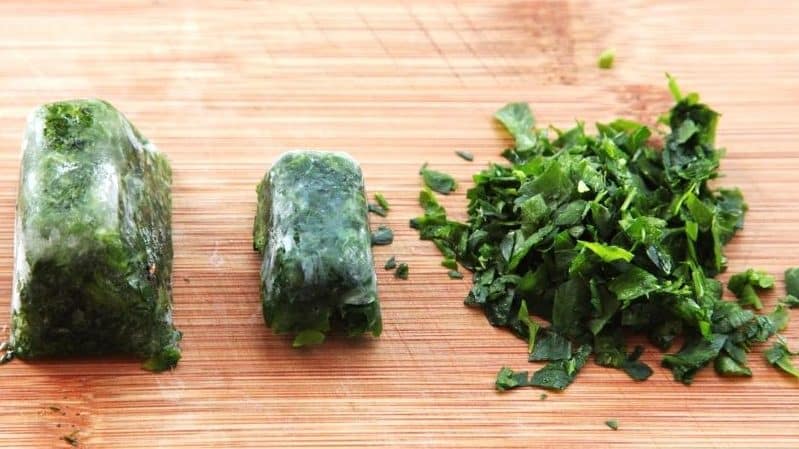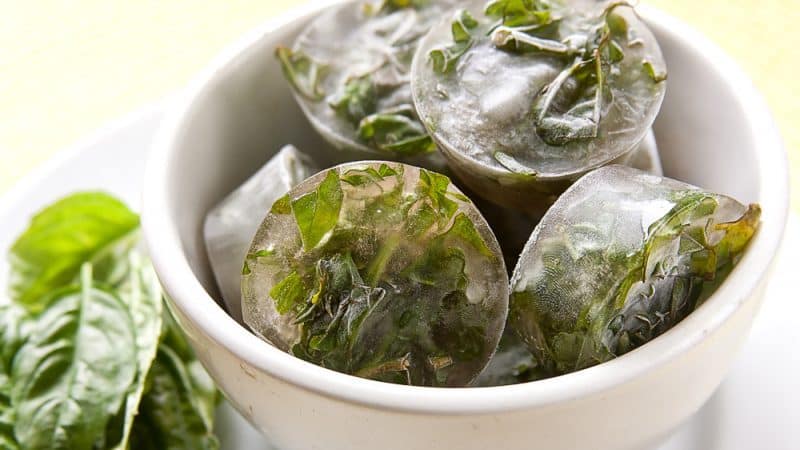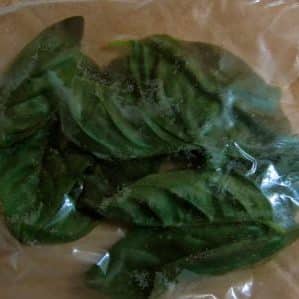How to properly freeze basil for the winter: a selection of the best methods
Winter is not a reason to deny your body vitamins. By freezing basil, you will provide yourself with a fragrant plant for several months. There are several ways to store spices in the freezer while preserving its beneficial properties and taste.
Let's consider the most popular freezing options, study the conditions and storage periods.
Can basil be frozen?

The quality of industrially frozen greens raises questions, because there is no guarantee that the products have not been defrosted and re-frozen. To be sure of quality, it is better to prepare basilica at home.
Advantages and disadvantages of this harvesting method
Freezing basil has several benefits:
- allows you to eat greens even in winter;
- preserves almost all the taste and nutritional properties of the plant;
- does not require much effort and time.
The only drawback of this harvesting method - free place. If you have a small freezer, you may not have much room to store basil. Then it makes sense to dry it.
Selection and preparation of greens

In the evening, water the plant so that it absorbs moisture well overnight and becomes softer and juicier. In the morning, young branches that have not yet begun to bloom are cut off with scissors.
Regardless of the freezing method, a number of preparatory procedures are carried out:
- Carefully inspect the leaves; discard any damaged, dry or diseased specimens. Dried foliage is still suitable for consumption, but is not at all suitable for long-term storage.
- Soak the leaves in water at room temperature for half an hour. A pinch of salt added to the water will get rid of insects remaining on the greens.
- Gently rinse the basil under running water.
- Place the leaves on a paper or waffle towel and wait until it completely absorbs the moisture.
Before freezing, prepare suitable storage containers. It is most convenient to use airtight containers or portioned bags with a zip fastener.
How to freeze basil for the winter
There are several ways to prepare basil for winter storage. When choosing, be guided by the amount of free space in the freezer and personal preferences.

Fresh
One of the easiest ways to freeze:
- Place the washed and dried leaves in a single layer on parchment paper. The leaves should not touch each other.
- Place the parchment in the freezer for 40 minutes so that the greens freeze a little.
- Transfer it into portioned bags, remove the air from them and place in the freezer for long-term storage.
Blanched
The blanched plant is not only stored for a long time, but also retains its appearance:
- Sort the basil leaves and wash them carefully.

- Prepare a container of boiling water. Place each basil leaf in boiling water for 10 seconds, no more. If you keep the foliage in hot water longer, it will simply cook.
- After boiling water, the leaves are immediately dipped into a container of cold water. If desired, add ice cubes to it.
- Remove the leaves from the cold water and place them on a paper towel to dry.Turn over periodically.
- Spread the dried herbs in a thin layer on parchment, tray or board.
- Place the product in the freezer before freezing. After this, transfer into portioned bags.
As a puree
Another way to prepare basil in portions for storage:
- Rinse the leaves under cold running water. Afterwards, place the basil in a container with water at room temperature for 30 minutes - this will help the plant absorb moisture.
- Then the basil is laid out on a towel to dry. To speed up the process, gently blot the foliage with a paper towel.
- Place the greens in a blender jar, filling it no more than halfway. Add 2-3 tbsp. l. olive oil – it will give the spice a richer taste and prevent it from darkening.
- Grind the basil until a thick, homogeneous mass is formed.
- Transfer the resulting mixture into ice-freezing molds and place in the freezer. After a day, remove the frozen cubes, place them in sealed bags and place them in the freezer for further storage.
In oil
Another preparation method:
- Wash and dry the basil.
- Cut the greens into large pieces.
- Place crushed leaves in ice cube trays or small containers.
- Pour oil over the greens so that it completely covers them. Place the basil in the freezer.
For this method, sunflower and olive oil or melted butter are suitable.
In the broth
The principle is the same as when freezing basil in oil. Any broth is suitable for pouring:
- vegetable;
- beef;
- chicken;
- pork.
Terms and conditions of storage
The shelf life of spices depends on the freezing method:
- Basil, frozen fresh, can be stored for 12 months;
- blanched or prepared in broth - 10-12 months;
- in puree form it can be stored in the freezer for no more than 4 months;
- leaves frozen in oil - up to 8 months.
Greens are kept in the vegetable compartment, away from meat or fish.
Important! Do not defrost or re-freeze basil - there will simply be no beneficial properties left in such greens.
It is most convenient to store the spice in small portions, which will be enough for one time. This way you don’t have to constantly take the food from the freezer and back.
How to defrost correctly
Proper defrosting will preserve the beneficial properties of the plant. Some recommendations will help with this:
- Remove fresh frozen basil from the freezer in advance and place it on the bottom shelf of the refrigerator until defrosted.
- Do not defrost whole basil leaves in water - they will give up all their beneficial substances to it.
- If the basil is frozen in the form of cubes and will be used to prepare soup, broth, pasta or other hot dishes, it should not be thawed first. Simply add the required number of cubes to hot water.
Where can I use it?
Frozen basil, like fresh basil, is widely used in cooking. It is added to:
- soups;
- meat and fish dishes;
- salads;
- pasta;
- sauces;
- lemonade;
- tea.
Cubes based on olive oil and basil will also be useful for home cosmetic procedures. They wipe the face with it to tone and improve color.
An infusion from the plant will increase appetite, relieve cramps and help with insomnia. In folk medicine, it is used as a remedy for treating gastrointestinal diseases and headaches.
This is interesting:
Do-it-yourself burning preparation: is it possible to freeze horseradish for the winter.
How to properly freeze gooseberries for the winter in the freezer: the best ways.
How to properly freeze carrots for the winter in the freezer.
Conclusion
To enjoy the healthy plant in winter, it is frozen fresh, blanched or pureed, filled with broth or butter. Freezing whole leaves allows you to store them for up to a year; using oil reduces this period by 2-4 months.
The defrosted plant is used for preparing first and second courses, sauces and salads.